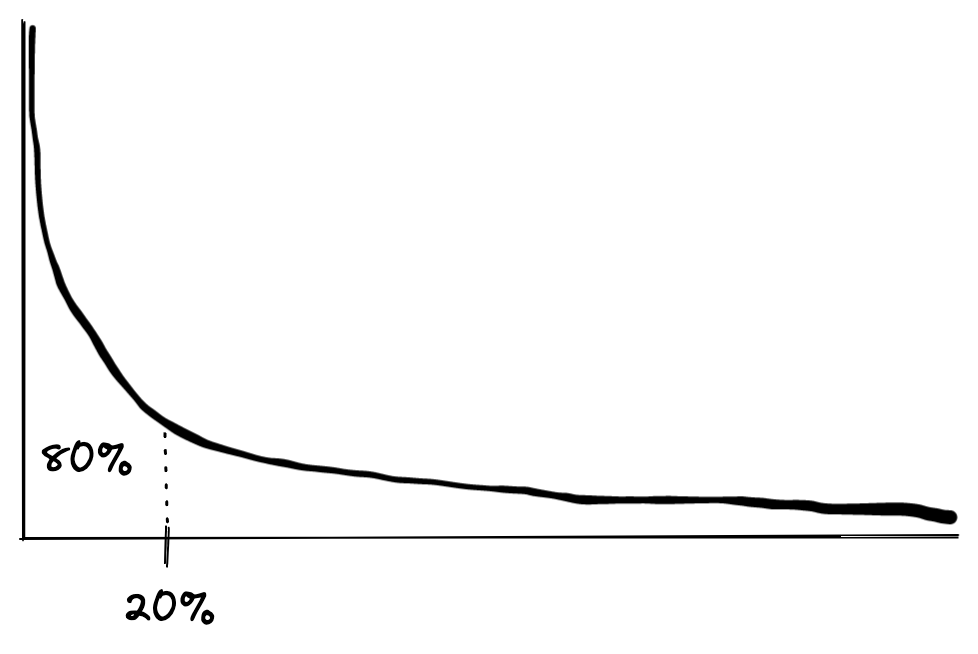How and where do you begin? If you’re justing getting started, the very beginning of the entrepreneurial journey seems the hardest. Those who have success have revenue numbers which seem out of reach, a follower count you can only dream of, and they seem to be everywhere.
The way I like to look at this is by acknowledging that Power Law is all around us. Probably 99/100 people reading this already heard it all before, but basically a power law describes a relationship between two quantities y and x such that y(x) = x ^ some power. When you plot a power law distribution it looks like this:

Another example of a power law relationship is the Pareto principle, or 80/20 rule, where 80% of the result is caused by 20% of cases. That’s the head of the graph. All the rest is in the long tail. You could put it even more bluntly and call it “winner takes all”.
It’s everywhere, in nature, life and business. From the distribution of crater sizes, the amount of food animals of a certain size need, the distribution of wealth across a society, pandemics.
Although you might want to call it the 99/1 rule instead. Inflation, a sign of the times.
So back to the beginning. What does this have to do with starting a business? Because so much in business follows this power law, looking at it in terms of power laws makes it simpler to understand why it seems difficult to start, and why success is in fact possible, and why certain routes are harder.
Audience, followers and marketing
For example, when looking at an existing large audience an established company has, it seems impossible to get there. You start out with 0 followers. Then finally you get your first follower or signup for your newsletter. Then finally another one, maybe 4 more. This will take forever! You’re at the end of the tail, and everything looks flat from here.
But. Power law! We see the same relationship in network effects, such as building communities, an audience or a following [1]. The value of a network goes up with the number of participants squared. So next time you send something to your followers, some in the network might notice it. Before you know it, people start sharing your content with some of their followers or friends. Slow at first, but the pace of new followers will pick up.
The important lesson here is to keep going. You shouldn’t look at the slow growth as it not working out, rather you are in the tail. This is the part where you shout in the void, and need to trust that it’s working. The network effect and power law are real. Similarly, you shouldn’t look at some other products following of 100K as unattainable, but rather see it as doubling only 16 times (of course it takes work, but that’s not impossible at all).
Content and thought leadership
The same applies to writing content and sharing ideas.
- 99% of all content is created by 1% of people
- 99% of the public debate is determined by 1% of the people (because they publish).
It looks like there is a lot of content out there, but related to the enormous size of the internet, there is almost none. That makes it way easier to have an impact on opinions, debates and establish yourself as a brand in a field you’re interested in.
- 99% of all traffic will come from 1% of your posts
- only 1% of all total views for your content will occur at the beginning
Almost nobody reads any of your content at the beginning, and that’s normal and expected. It’s important to keep publishing because you need the numbers to get to that 1% post which will do well (and make the rest of the content work you did compound).
Launches, internet points and product-market fit
Just to name some well-known examples to many startup founders: 1% of launches on ProductHunt will get 99% of votes, only 1% posts of Hacker News will get any traction at all. When a submission to one of those sites gets traction, the long tail of upvotes will just be a handful. You need to get to the 20/80 inflection point of the graph where suddenly it takes off and starts collecting all the other votes.
Having a great post or product is completely necessary to do that, of course. But the difference between 1000 upvotes and 1 upvote is not 1000x. It’s a few votes at the beginning, after which you’ll get the 99% of other votes. Again, good to realize this and not get discouraged and take one launch of a feature or product which failed to get traction as evidence that the entire concept is flawed.

The same goes for product-market fit. It’s a lot of long tail small changes which can suddenly bring you to the 80/20 inflection point where things really take off. Once things grow really quickly, you haven’t put in 1000x times the work, but a few doublings in the tail (which are just small numbers) brought you to this moment. From there on, everything goes quickly (feedback, revenue, press, and so on).
Competition
You will only have heard of a few big players (1%) in the market. They seem to be everywhere, but in fact there’s an entire long tail of businesses which have customers! Depending on the market, that long tail can be very lucrative. If you want to build a nice lifestyle business, don’t overlook big markets because there are a few large players. Build in the niches of the long tail.
Looking to become a big player in the field yourself, but see a lot of players? Only 1% of those will become really big, so if you’re willing to go for it, there’s less competition than you think.
Customers, support, reviews and pricing
Let’s end with a few more:
- 1% of your customers will be your biggest fans and spread the word. That’s why your MVP needs to focus on getting those!
- 99% of support is going to come from 1% customers. Don’t be afraid to “fire” them if it becomes unreasonable.
- Likewise, most revenue is going to come from a few customers and few price plans. Make sure your pricing plans follow the power law, and allow customers who see a lot of value to subscribe to a high pricing plan!
- There will be features which are only used by 1% of customers. Likewise, the vast majority of customers will only use a few core features. The long tail of customers which those extra features bring in will be relevant over time, but no need to launch with those.
[1] Slightly related to the topic of audiences, I like this TED talk by Derek Sivers about starting a movement (https://www.youtube.com/watch?v=V74AxCqOTvg). I just watched it again, and without measuring the exact seconds, I’m pretty sure the number of people dancing along follows a power law.


